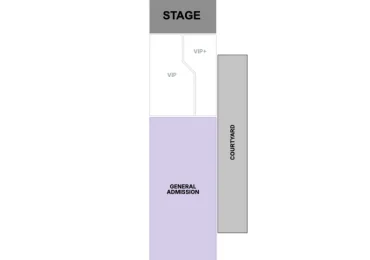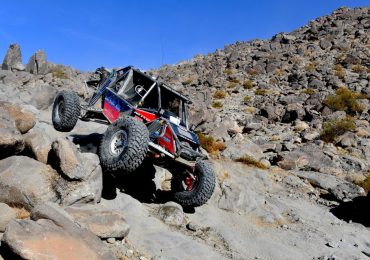After more than two years of talk and many testing miles in secret, the Extreme H car finally broke cover last weekend for its first public outing.
The Pioneer 25’s running at the Hydro X Prix in Scotland last weekend was a momentous occasion for a number of reasons. Not only was it the first time the car had taken to a track in public –and in full view of all current teams and drivers — but it was the first time the car had run on a full Extreme E course. It was also the first time it had been properly benchmarked alongside its predecessor — Extreme E’s venerable Odyssey 21 — too.
Talk around the car has already been positive, with it having completed 1,100 miles of running across a number of locations in France in the last year, but there was no hiding Extreme E and Extreme H technical director Mark Grain’s delight at the end of the Scotland race week, where the car ran on both race days, as well as during the days in the build-up.
“I’m very happy,” Grain tells RACER. “It allowed us the opportunity to run the car absolutely alongside the Extreme E cars in the sense that we were using the same course, same weather conditions, we had Alkamel on-site for the telemetry, Aurora TV, everything, so it really gave us that good opportunity to take the car and do all of that work that we can’t do when we’re private testing.
“But of course, it’s the first time that a hydrogen car has run in these conditions — it wasn’t parade laps, it wasn’t just a show for the public, it was out there for a proper development purpose, using all of the Extreme E track and facilities.”
 The opportunity to test the Extreme H car at the same venue as the current Extreme E cars provided the opportunity for the test team to make direct comparisons. Colin McMaster / LAT Images)
The opportunity to test the Extreme H car at the same venue as the current Extreme E cars provided the opportunity for the test team to make direct comparisons. Colin McMaster / LAT Images)
Extreme E podium finisher Hedda Hosaas was tasked with all of the driving in Scotland, as her fellow tester Romain Dumas was busy winning the Goodwood Festival of Speed timed shootout in Ford’s all-electric Supervan 4.2. But not only did she get extra seat time as a result, the success of the test led to it being extended, too.
“It’s been a good week,” she says. “I was able to drive the Pioneer 25 more than planned and there was more seat time as the team extended the program. It’s been good — the team brough new things to test, sometimes bringing new challenges and niggles but that’s what testing is for.
“By the end we were putting in consecutive hard laps — including on proper mud — and the car handled really well. It’s definitely an improvement on the Extreme E car.”
 Along with its revolutionary power source, the Pioneer 25 offers some key upgrades to the chassis over its electric predecessor.
Along with its revolutionary power source, the Pioneer 25 offers some key upgrades to the chassis over its electric predecessor.
While much of the focus has, understandably, centered around the car’s hydrogen power source, manufacturer Spark has delivered wholesale improvements across the board, something that could clearly be seen trackside as it ran in the same environment as the car it will replace. All-new suspension from Fox means the car is notably better in the corners and on uneven surfaces, while a new central driving position and revised battery — which now sits lower and more centrally in the car’s chassis — have further aided balance and handling.
“You’ve got an Extreme E car turning laps, and then shortly afterwards you’ve got the Extreme H car turning laps,” Grain points out. “So you can see the step in performance and the way the Extreme H car is handling and performing compared to Extreme E.”
“It feels better, especially at low speed where we can gain the most because of the power we have now — I could really feel it,” Hosaas adds. “It felt smooth and fast in the technical slow-speed sections — I was pushing and it gives you a lot of confidence now.
“The visibility’s way better, too. You see more because of the center positioning in the Pioneer 25. This will be great when you’re racing to have that broader vision range.”
Those changes across the board have delivered a substantial step up, and while Grain wouldn’t be drawn on specific lap times, he did confirm it is already a quicker car, despite still being in the relative early days of its gestation.
“It’s better,” Grain says with a big smile. “It’s a faster race car, we’ve seen that in the data, and we were working through a development program and a test program, so it’d be unfair to put a lap time number on it. But the hydrogen car was faster.”
The car ran multiple race distances on the Hydro X Prix track in Scotland, while also running on a separate shorter course at the race site typically earmarked for battery testing. The variation in test tracks, which were both on surfaces different to the previous tests and that are more representative of race conditions, allowed the development team to check off even more items, putting the car through a range of different forces that it could be expected to face across a wildly varied race season.
“The short course is quite developed so even though it’s short, it’s got a nice combination of corners, so that allowed us to understand braking forces in the slow stuff,” Grain explains. “But then there was a high-speed left-hander which allows for a high degree of lateral G and some of the programs that we were working on and some of the software, the team really benefited from having that different combination of braking forces, accelerating, and the longitudinal and lateral G that we could get out of that short course.”
 It handled the Scottish course with aplomb, but how will the Extreme H car react to the leaps and bounds of Sardinia We’ll soon find out. Sam Bloxham/Motorsport Images
It handled the Scottish course with aplomb, but how will the Extreme H car react to the leaps and bounds of Sardinia We’ll soon find out. Sam Bloxham/Motorsport Images
Still, every box isn’t ticked. Next up for the test team is a trip to Sardinia — widely regarded as Extreme E’s most brutal race site — where it will once again run in race-like conditions, and alongside the Extreme E car across consecutive race weekends.
“We’ll have even more testing days because it’s a back-to-back event,” Hosaas says. “It’s going to be a good one because we have driving on that very fast track compared to Scotland.
“I think it’s a good track to test on because it’s usually the most extreme and has some big jumps. That’s going to be exciting because it is so responsive in those areas. I think it’ll be pretty cool on the big jumps.”
While individual race distances were completed in Scotland more than once, one of the key aims in Sardinia will be to complete a cumulative race weekend of mileage on a championship track at the same time an actual event is taking place.
“We’ve got an extensive program there with two full days on the full course, but we’re also going to make use of the opportunity again to use the shorter course again in Sardinia — that’s already mapped out and we’ve got a run plan arranged for that — and then use the full course,” says Grain. “But we also want to run the car, like we did in Scotland, on the Sunday as well.
“That’s in development — how that can work and whether it’s the first Sunday or the second Sunday — but we are working on that actively, so (there will be) a lot of track activity with the hydrogen car in Sardinia.”
The Extreme H car’s race testing program resumes in the second week of September, where rounds 5-8 of the 2024 Extreme E championship will take place.









